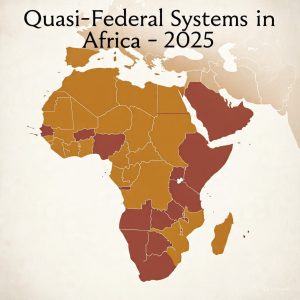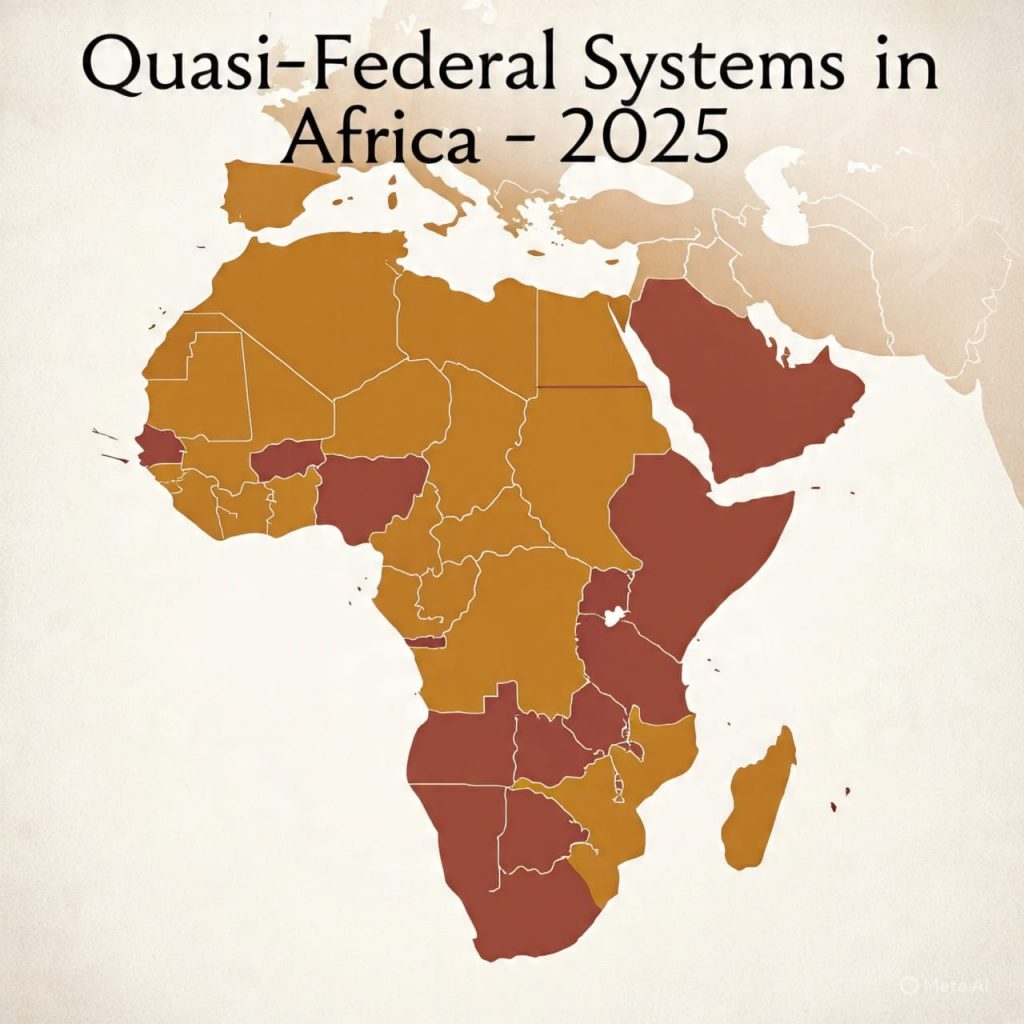In Summary
- Quasi-federal by law means subnational units have constitutionally defined powers, but ultimate sovereignty remains with the national government.
- These systems are designed to balance regional diversity with national unity, embedding local authority within a legal framework that preserves central supremacy.
- Examples include Comoros, with its autonomous islands under a Union framework, and South Sudan, where states have constitutionally guaranteed powers while the national government retains control over national policy.
Deep Dive!!
Lagos, Nigeria, Tuesday, November 11 – Africa’s governance landscape is legally diverse, encompassing unitary, federal, quasi-federal, monarchical, and hybrid systems. Each system reflects a legal framework defining the distribution of power between central and subnational governments. A unitary state centralizes authority under a single national government, granting subnational entities only delegated powers.
In contrast, a federal system, like Nigeria or Ethiopia, legally divides sovereignty between the national government and constituent states, embedding autonomy constitutionally and guaranteeing powers that cannot be unilaterally revoked.
Between these extremes lies the quasi-federal system by law, where constitutions grant partial autonomy to subnational units while maintaining central supremacy. Unlike full federations, quasi-federal arrangements are designed to accommodate regional diversity or historical agreements without fully ceding constitutional authority to subnational entities.
Legally, these systems recognize regional governments and assign specific powers, but the central government retains overriding authority over national policy, defense, fiscal control, and critical legislation. Quasi-federalism is often adopted to balance national cohesion with regional identity, ensuring that local governance can operate within legal limits defined by the constitution.
In Africa, quasi-federal systems are established in countries where law defines regional autonomy but limits sovereignty, typically granting subnational units legislative, administrative, or fiscal powers while keeping central oversight paramount.
This article ranks African countries with quasi-federal systems strictly by legal adoption, from the earliest constitutionally defined frameworks to the most recent. It focuses on the laws, constitutional instruments, and reforms that establish quasi-federal authority, highlighting how each country balances local governance with national control.
3. South Sudan
South Sudan’s quasi-federal framework is established under the Transitional Constitution of 2011, adopted following independence from Sudan. By law, the country is organized into a three-tier system of government: national, state, and local levels. The constitution grants states authority over local governance, including healthcare, education, infrastructure, and resource management, while the national government retains exclusive control over defense, foreign affairs, currency, and national economic policy. This legal design defines South Sudan as a quasi-federal system, providing significant subnational powers without creating full constitutional sovereignty for the states.
The constitution delineates state powers and national oversight, embedding mechanisms for cooperation and coordination between government levels. States are empowered to pass legislation on devolved matters, establish executive offices, and manage local administrations, but all actions are subject to compliance with national law. By law, this framework ensures that regional authority exists within a controlled legal structure, preventing unilateral secession or overreach while allowing localized decision-making to address regional needs.
Implementation of quasi-federalism in South Sudan has focused on building state institutions capable of executing devolved functions. States such as Central Equatoria and Upper Nile have developed ministries, assemblies, and local administrative offices to manage civil service, healthcare, education, and infrastructure projects. Revenue collection and fiscal management are guided by legal frameworks that combine local taxes with allocations from the national government, ensuring both autonomy and alignment with national priorities.
Ongoing reforms emphasize institutional strengthening, clarity of powers, and service delivery. International partners, including the UN, African Union, and World Bank, have supported capacity-building programs for state civil services, public finance, and governance. By law, South Sudan’s quasi-federal system demonstrates how legal frameworks can provide decentralized authority while preserving national unity, offering a model for managing diversity, enhancing local governance, and operationalizing constitutional autonomy without creating a full federation.

2. Sudan
Sudan’s quasi-federal framework is grounded in the Comprehensive Peace Agreement (CPA) of 2005, which ended decades of civil conflict and established legally recognized regional autonomy. Under the 2005 Interim National Constitution (INC), Sudan was organized as a decentralized state with autonomous regions granted constitutionally defined powers over local governance, including health, education, agriculture, infrastructure, and resource management, while the national government retained exclusive authority over defense, foreign affairs, and national economic policy. This legal arrangement provides a quasi-federal system by law, granting subnational units authority within a framework of central supremacy.
The CPA and INC codified provisions for power-sharing, revenue allocation, and dispute resolution between the national government and autonomous regions. States such as Darfur, Blue Nile, and South Kordofan were given authority to legislate on devolved matters, manage local administrations, and oversee law enforcement, while the national government retained ultimate control over national policy. Legally, this ensures that states participate in governance without possessing full constitutional sovereignty, reflecting a deliberate balance between autonomy and national unity.
Implementation of quasi-federalism involved establishing state-level institutions with legislative assemblies, executive offices, and local administrative structures to manage devolved functions. States were empowered to oversee the construction and operation of schools, hospitals, and road networks, while coordinating with the central government on budgets and development planning. The INC also included mechanisms for intergovernmental cooperation and dispute resolution, reinforcing the legal supremacy of national authority while protecting subnational powers.
Ongoing reforms, including post-2019 transitional arrangements, continue to maintain legally defined state authority while strengthening national oversight. By law, Sudan illustrates how a quasi-federal system can be codified to accommodate regional diversity, address historical grievances, and promote stability, providing legally guaranteed subnational autonomy without ceding national sovereignty.
1. Comoros
Comoros operates under a quasi-federal system codified by its Constitution of 23 December 2001, with subsequent amendments in 2009, 2014, and 2018. The Union comprises three islands: Ngazidja (Grande Comore), Ndzuwani (Anjouan), and Mwali (Mohéli), each granted constitutional autonomy over local governance while the Union government retains control over strategic matters such as foreign affairs, defense, and currency. By law, the islands manage internal affairs including taxation, local infrastructure, education, and health services. This legal framework establishes Comoros as a quasi-federal state, balancing island autonomy with Union authority.
The Constitution provides a federacy-style arrangement, requiring the Union president to be assisted by vice presidents representing each island. This ensures rotational leadership and equitable representation across islands. Legislative powers are divided, with each island maintaining its own assembly responsible for local laws within the bounds of Union legislation. National laws prevail over island laws in matters designated as Union powers, clearly defining the legal hierarchy and limits of autonomy, which is a hallmark of quasi-federal systems.
Implementation of quasi-federalism in Comoros involves island-level governance structures, including presidents, local assemblies, and administrative offices that manage day-to-day operations. Each island is responsible for delivering public services, managing budgets, and overseeing infrastructure projects while coordinating with the Union government on strategic policies. For example, Ngazidja manages its own primary healthcare system, education initiatives, and local roads, reflecting constitutionally guaranteed autonomy while remaining legally subordinate to the Union in national matters.
Ongoing reforms in Comoros have reinforced legal clarity and governance capacity. The 2018 constitutional amendments refined the rotational presidency among the islands and clarified the powers of the Union versus the island governments. Institutional mechanisms, such as intergovernmental coordination committees, support dispute resolution and harmonization of policies. By law, Comoros demonstrates how a small-state quasi-federal system can legally balance regional autonomy with central authority, providing a framework for governance that respects local identity while maintaining national cohesion.
We welcome your feedback. Kindly direct any comments or observations regarding this article to our Editor-in-Chief at [email protected], with a copy to [email protected].


